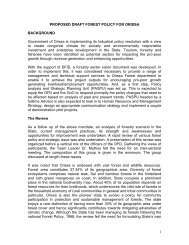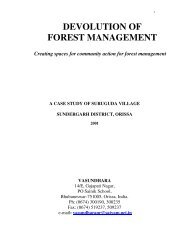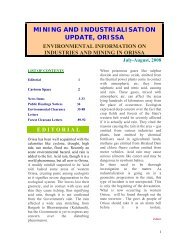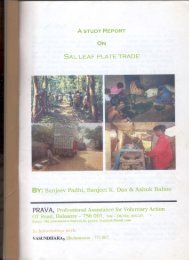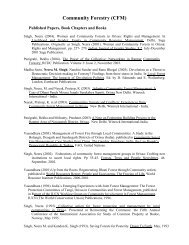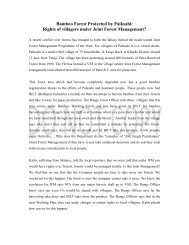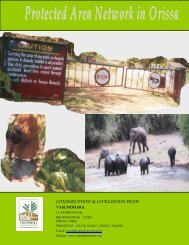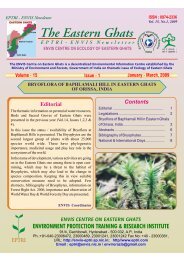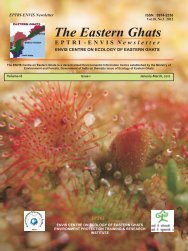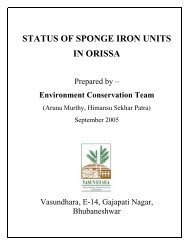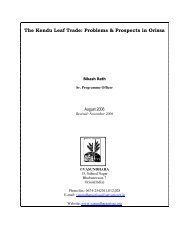Bamboo in Orissa: Trade and Livelihood Perspective - Vasundhara
Bamboo in Orissa: Trade and Livelihood Perspective - Vasundhara
Bamboo in Orissa: Trade and Livelihood Perspective - Vasundhara
Create successful ePaper yourself
Turn your PDF publications into a flip-book with our unique Google optimized e-Paper software.
All rights reserved by VASUNDHARA(www.vasundharaorissa.org). For any clarification, contact author at sunlit1968@yahoo.co.<strong>in</strong><br />
bamboo artisans among the total population of 700 HHs; but the rule for bamboo<br />
harvest<strong>in</strong>g is same for them like other villagers.<br />
3. Industrial bamboo<br />
In 1988, OFDC sold <strong>in</strong>dustrial bamboo at Rs.700/SU of salia. This price was fixed by the<br />
Empowered Committee on bamboo, <strong>and</strong> <strong>in</strong>cluded Rs.115 as royalty, Rs.30 as OFDC’s<br />
commission <strong>and</strong> Rs.310 as work<strong>in</strong>g cost, plus other expenses. Price for daba IB was fixed<br />
at Rs.1020/SU.<br />
Dur<strong>in</strong>g that year(1988-89), OFDC supplied 11000 SU to OP Mill, 109482 SU to Straw<br />
Products, <strong>and</strong> 3913 SU to Bhadrachalam Paper Board.<br />
In 1989-90, the price <strong>in</strong>creased to Rs.735 for salia, <strong>and</strong> Rs.1890 for daba, per sale unit. The<br />
break-up for salia IB was as under:<br />
Work<strong>in</strong>g cost:<br />
Forest <strong>and</strong> depot exp.- Rs.255<br />
Establishment- Rs.70<br />
Silvicultural expenses:<br />
Reserve fund:<br />
Agent commsiion to OFDC:<br />
Royalty to govt:<br />
Total:<br />
Rs.20<br />
Rs.24<br />
Rs.30<br />
Rs.336<br />
Rs.735<br />
Cost of production of daba IB was normally expected to be 2.5 times that of salia IB, <strong>and</strong><br />
hence the sale price of daba was often fixed on this basis 35 .<br />
By late ‘90s the situation has changed a lot. On one h<strong>and</strong> the paper mills went through a<br />
period of depreciat<strong>in</strong>g market prices of paper <strong>and</strong> on the other h<strong>and</strong>, some of them adopted<br />
advanced technology of us<strong>in</strong>g hardwood pulp with bamboo at 80:20 ratio so that the<br />
production cost could be reduced to cope with the situation. At that time bamboo<br />
purchased from OFDC costed them about Rs.1650 per MT as aga<strong>in</strong>st Rs. 750 to 1400 for<br />
the timber of firewood species like chakunda <strong>and</strong> casuar<strong>in</strong>a etc.. Aga<strong>in</strong> transportation cost<br />
was about Rs.3000/MT of bamboo as aga<strong>in</strong>st Rs.2000 for wood. This way the cost of the<br />
raw material was significantly less if they used wood <strong>in</strong> place of bamboo. Further,<br />
purchas<strong>in</strong>g bamboo from OFDC <strong>in</strong>volved a complex paper work <strong>and</strong> several<br />
responsibilities(like transit permits) which was not there if they purchased wood from<br />
private traders or plantation owners. Hence, the mills avoided the lift<strong>in</strong>g of about 68000<br />
MT of bamboo stacked for their use <strong>in</strong> OFDC godowns dur<strong>in</strong>g 1999-2000 (RCDC, op.cit.,<br />
p.3).<br />
35 S<strong>in</strong>ce 1 daba SU is regarded to be equivalent to 2.5 salia SUs, hence the price is normally fixed<br />
accord<strong>in</strong>gly. For <strong>in</strong>stance, the Empowered Committee fixed the price for salia @Rs.1272/SU for the year<br />
1995-96, <strong>and</strong> that for daba @Rs.3180 (1272 X 2.5).<br />
72



